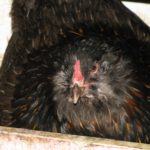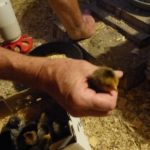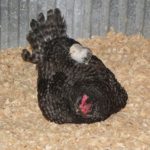We like our small flock of hens and the delicious eggs they give us each day. Although a hen can live for ten or a dozen years her laying slows after two or three years. After that, it declines steeply. Eventually, she might only lay an egg or two a year!
To keep a steady supply of eggs for the kitchen we need to occasionally replace old hens with younger ones, and we’ve learned a trick that works well. We enlist the help of a broody hen.
When a hen develops a mothering instinct she’ll stop laying, puff up her feathers, and change her vocabulary. She’s broody. Then she’ll sit and sit on eggs, hoping they’ll magically transform into baby chicks. We don’t have a rooster so the eggs are infertile. She can sit for eternity and they’ll never hatch. So we use a trick to help her have a happy motherhood and produce new replacement egg layers. Here’s what we do:
When a hen begins sitting we put a half dozen golf balls in an extra nest that we keep in storage. We put the broody hen and her nest isolated from the other hens in a separate coop. Usually, she quickly settles down and keeps those golf balls comfortably warm.
After she’s been sitting for a couple of weeks we buy chicks from a nearby farm store or hatchery. When darkness descends we enter the coop with the chicks and gently place them under the broody. She immediately senses that her golf balls have hatched and adopts the babies. Her clucking vocabulary changes and she’ll keep her babies warm. The following morning she’ll lead her chicks out of the nest and begin teaching them how to find food and stay safe.
- Broody Hens sit quietly.
- After dark, slip chicks under the mama hen.
- Chick on mama hen’s back
It always amazes us how quickly the broody changes from the trancelike incubation phase to active motherhood. We keep the chicks and their mom separate from the other adult chickens for six or seven weeks until they’ve grown quite a bit and then intermingle them.
There are several ways to dispose of elderly hens. One is to transition them into stewing chickens, but most people don’t want to kill their hard-working hens. A less lethal way is to advertise them for sale at a bargain price on a social media list. Usually, they’ll be sold within a few days. Four to five months after hatching, our new pullets will lay their first egg.





I love this process especially using the golf balls. Peter will have to read this and enjoy as well.